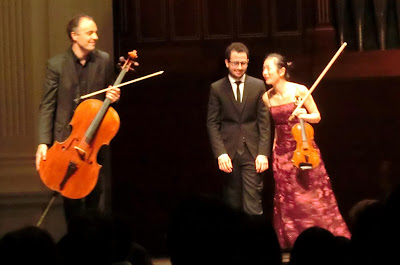BEETHOVEN HEROIC YEARS
Tang Tee Khoon Grand Series
Victoria Concert Hall
Sunday (28 May 2017 )
This review was published in The Straits Times on 30 May 2017 with the title "Beethoven in an informal and intimate setting".
Singaporean
violinist Tang Tee Khoon is a one-woman chamber music festival. The series
of concerts which bear her name has reached
its 10th edition, its curatorship distinguished by astute thematic
programming and the involvement of classy international soloists.
This
year's first programme was headlined by Beethoven, highlighting his later
“Middle period” compositions marking a maturity definitively influenced by his
deafness. There were two parts to the programme. The first was an hour-long
“Sharing Recital”, where about 75 listeners crammed the stage of Victoria
Concert Hall to hear Italian pianist Luca Buratto and Taiwan-born violist Huang
Hsin-Yun speak and perform.
 |
| The Sharing Recital in progress, as Tang Tee Khoon (extreme right) looks on. |
The
session was informal and intimate, opening with the fiery Appassionata
Sonata from Buratto's capable hands. It closed with the viola version of
the D major Cello Sonata (Op.102 No.2), which was relative brief and
finished with a fugue. Huang's viola had a deep sonorous tone but sometimes got
submerged by the piano.
 |
| Beethoven, Ligeti, and Beatles, why not? |
In
between, both musicians mused about 20th century Hungarian composer
Gyorgy Ligeti's free-spirited nature as a parallel to Beethoven's own trail-blazing
streak. Huang played a movement of Ligeti's Viola Sonata, using natural
rather than tempered scales for an earthy folk-inflected sound. Buratto
delivered the complete Book 3 of Ligeti's finger-twisting Etudes with
unnerving ease.
The
Evening Concert showcased three great Beethoven works dating from 1810 to 1811,
performed in order of publication. The String Quartet in F minor
(Op.95), carrying the title “Serioso”, was an epitome of clarity and
tautness. The parts of Kim Min-Young (1st violin), Tang (2nd
violin), Huang (viola) and Adrian Brendel (cello) were clearly discerned
whether in the unison, as in the arresting opening, or in the counterpoint of
the slow movement's fugue.
Instrumental
balance was excellent as was interplay, and this spirit prevailed in the urgent
and moody Scherzo before relaxing in the Finale, where the fast-flowing
narrative gave way to outright jollity in the comedic buffo-like coda,
something which Mozart was also wont to do.
Tang
was joined by Buratto in Beethoven's tenth and last Violin Sonata in G
major (Op.96). Contrasted with the tension-laden string quartet, the sonata was
more congenial with its four movements radiating mostly sunshine. The mood was
maintained through Tang's lively interpretation and Buratto's crisply minted
fingerwork, culminating in the finale's playful set of variations.
Duo
became trio when Brendel joined in for the great “Archduke” Piano
Trio in B flat major (Op.97), named after Beethoven's patron Archduke
Rudolf of the Habsburg dynasty. This was a performance of nobility, the broad 1st
movement theme striding aristocratically with Brendel's generous cello tone
being a key factor.
There
were pizzicatos and smiles in the Scherzo, where lightness reigned
before a hymn-like theme introduced by piano was subjected to sublime
variations in the 3rd movement. Within a bar's notice, the reverie
turned into the Hungarian-flavoured finale, the infectious humour of which
brought the evening's fare to a satisfying close.






No comments:
Post a Comment